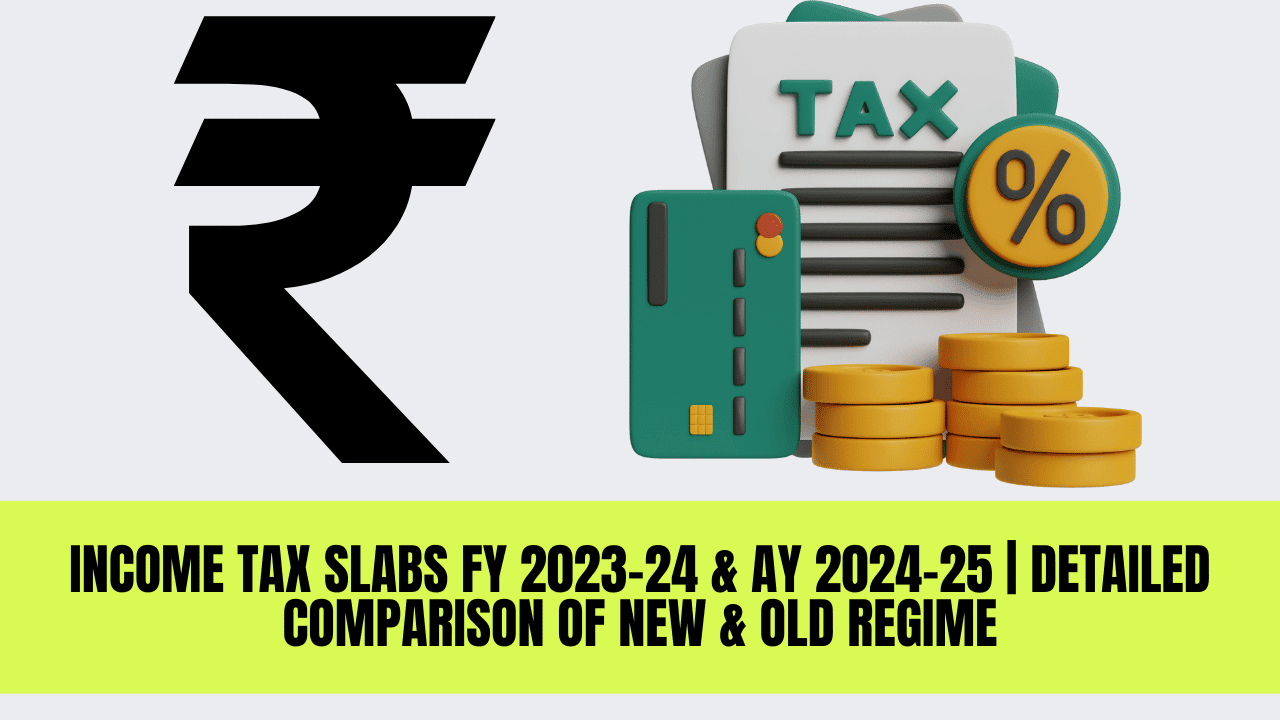Income Tax Slabs FY 2023-24 & AY 2024-25: In India, income tax is determined by the income tax slabs and rates set annually. These slabs vary between the old and new tax regimes. For this year, starting from April, the applicable income tax slab will be for the financial year 2024-25, with the assessment year being 2025-26.

Income Tax Slabs Under Old Tax Regime
The old tax regime allows taxpayers to claim various deductions and exemptions, such as House Rent Allowance (HRA), Leave Travel Allowance (LTA), and deductions under Sections 80C, 80D, and more.

The Income Tax’s previous tax regime is categorized into three groups:-
- Indian Residents aged below 60 years and all non-residents
- Resident Senior Citizens (aged 60 to 80 years)
- “Resident Super Senior Citizens” (Or < 80 years)
Here are the income tax slabs under the old tax regime of the Income Tax Act, of 1961.
For Indian Residents aged below 60 years and all non-residents
| Income Range | Tax Rate |
|---|---|
| Up to Rs. 2,50,000 | NIL |
| Rs. 2,50,001 to Rs. 5,00,000 | 5% |
| Rs. 5,00,001 to Rs. 10,00,000 | 20% |
| Above Rs. 10,00,000 | 30% |
For Resident Senior Citizens: (60 – 80 Age)
| Income Range | Tax Rate |
|---|---|
| Up to Rs. 3,00,000 | NIL |
| Rs. 3,00,001 to Rs. 5,00,000 | 5% |
| Rs. 5,00,001 to Rs. 10,00,000 | 20% |
| Above Rs. 10,00,000 | 30% |
For Resident Super Senior Citizens (Or > 80 years)
| Income Range | Tax Rate |
|---|---|
| Up to Rs. 5,00,000 | NIL |
| Rs. 5,00,001 to Rs. 10,00,000 | 20% |
| Above Rs. 10,00,000 | 30% |
The Changes Announced in the New Tax Regime in Budget 2023, Why?
“The latest budget for 2023 was announced by Finance Minister Nirmala Sitharaman”, who introduced several changes to the new tax regime for the Financial Year 2023-24 and Assessment Year 2024-25. Here are the key updates outlining the new tax regime for FY 2023-24 and AY 2024-25.”
| Aspect | Details |
|---|---|
| Increased Basic Exemption | ₹3,00,000 (up from ₹2,50,000) |
| Revised Tax Slabs | – Up to ₹3,00,000: Nil<br>- ₹3,00,001 to ₹6,00,000: 5%<br>- ₹6,00,001 to ₹9,00,000: 10%<br>- ₹9,00,001 to ₹12,00,000: 15%<br>- ₹12,00,001 to ₹15,00,000: 20%<br>- Above ₹15,00,000: 30% |
| Standard Deduction | ₹50,000 for salaried individuals<br>₹15,000 for family pension |
| Rebate Under Section 87A | Individuals earning up to ₹7,00,000 annually will not have to pay income tax |
| Default Tax Regime | New tax regime is the default option; taxpayers can opt for old regime if preferred |
| Surcharge Rate | Highest surcharge reduced from 37% to 25% |
This table summarizes the key updates to the new tax regime announced in Budget 2023 for FY 2023-24 and AY 2024-25.
Income Tax Slabs For Companies & Businesses
Certainly! Let’s discuss the tax regime for companies and businesses for Financial Year (FY) 2023-24 under the new tax regime:
Tax Regime for Companies and Businesses (FY 2023-24)
- Corporate Tax Rate:
- The corporate tax rate remains at 25% for domestic companies whose turnover does not exceed ₹400 crore in FY 2021-22.
- New Manufacturing Companies:
- New manufacturing companies incorporated after October 1, 2019, have the option to pay tax at a reduced rate of 15% (without any exemptions) if they commence production by March 31, 2023, and are not engaged in any business other than manufacturing or production.
- Minimum Alternate Tax (MAT):
- MAT continues to be applicable at the rate of 15% on book profits for companies not opting for the concessional tax regime.
- Surcharge:
- Surcharge rates apply based on the income level of the company:
- 7% surcharge on companies having income between ₹1 crore and ₹10 crore.
- 12% surcharge on companies having income above ₹10 crore.
- Surcharge rates apply based on the income level of the company:
- Dividend Distribution Tax (DDT):
- DDT has been abolished. Instead, Rather, dividend income is now subject to taxation directly in the hands of the shareholders.
- Additional Deductions and Incentives:
- Companies can avail deductions under various sections such as 80C, 80D, etc., subject to specified conditions.
- Advance Tax:
- Companies are required to pay advance tax in four installments during the financial year.
- Compliance and Filing:
- Companies must file their income tax returns (ITR) and comply with tax audit requirements, if applicable, by the due dates specified under the Income Tax Act.
This tax regime for companies and businesses aims to provide a stable and predictable tax environment while promoting manufacturing and economic growth.
In our new article, we have shared all the information related to the Income Tax Slabs FY 2023-24 & AY 2024-25 with you. If you found all the information provided in our article helpful, please let us know by commenting once, and don’t forget to share it on your social media accounts. Also, be sure to visit our website’s homepage, Income-Mall.

